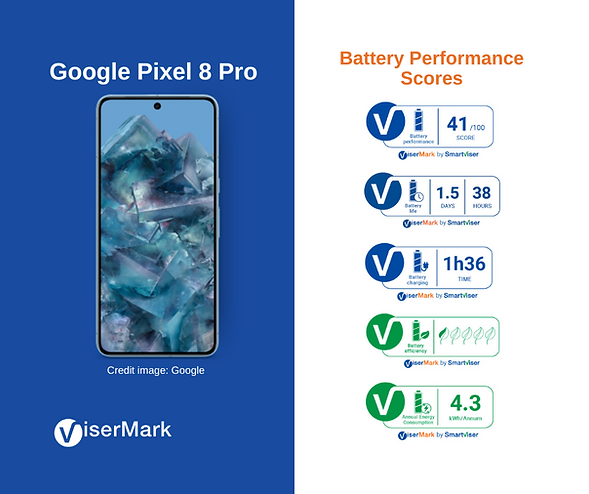Battery Showdown: Why Mid Tier Smartphones Outlast Flagship Giants
- Debbie Bouffler
- Aug 12, 2024
- 3 min read

Battery performance is often a critical factor when evaluating smartphones that can significantly impact user satisfaction. Traditionally, Flagship/Pro (€700 +) smartphones are expected to outshine Mid Tier (€200-€499) ones due to their premium pricing and advanced technology. However, data from ViserMark’s battery performance labels and battery consumption test results reveal surprising insights that challenge this conventional wisdom, particularly in everyday tasks.
Battery Life: Flagship vs. Mid Tier Smartphones
On average, Mid Tier smartphones demonstrate impressive battery life, often outperforming Flagship phones. For instance, the Xiaomi Redmi Note 12 5G delivers a remarkable 2.5 days of use or 61 hours of battery life, according to ViserMark labels.

In contrast, Flagship/Pro smartphones like the Samsung Galaxy S24 and Google Pixel 8 Pro offer around 1.5 days of use, between 34 to 38 hours of use despite their cutting-edge features and higher price tags.
This discrepancy can be attributed mainly to the power consumption patterns during everyday tasks. Flagship/Pro smartphones typically consume more power due to their advanced processors, higher-resolution screens, and additional features.
For example, during social media usage, the Samsung Galaxy S24 Ultra shows significantly higher power consumption, drawing around -803 mAh, compared to the Samsung Galaxy A15 from the Mid Tier, which consumes -785 mAh. While the difference may seem small, it accumulates over the day, leading to a shorter overall battery life for Flagship/Pro mobile phones.

However, when it comes to media playback, mid-tier models often show more efficient energy use. For example, the Xiaomi Redmi Note 12 5G (Mid Tier) consumes -364.01 mAh, which is less than the -528.34 mAh consumed by the Flagship/Pro Samsung Galaxy S23 Ultra. This suggests that Mid Tier smartphones can offer better energy management during specific tasks like media playback, extending battery life without sacrificing too much in terms of functionality.
Efficiency in Everyday Tasks
The ViserMark test results also highlight how Mid Tier smartphones maintain energy efficiency across various everyday tasks. For instance, during web browsing, the Motorola Moto G34 consumes -373 mAh, significantly more than the Samsung Galaxy S24 at -266 mAh.
This efficiency extends to other activities like emailing and media playback, where Mid Tier phones like the Xiaomi Redmi Note 12 Pro 5G consistently show lower power consumption, allowing for longer uninterrupted use throughout the day.
Another example is camera usage. The Google Pixel 8 Pro, a Flagship/Pro device, consumes -784.95 mAh, whereas the Realme Narzo 50, a Mid Tier phone, uses around -699.91 mAh for the same task. This suggests that while Flagship/Pro phones offer superior camera features, Mid Tier phones strike a better balance between functionality and power consumption, offering a more sustainable user experience.
Consumer Implications and Insights
For consumers, these insights suggest that Mid Tier smartphones offer a compelling balance between performance and battery life, often rivalling, and sometimes exceeding, Flagship/Pro models in terms of energy efficiency. This is particularly relevant for users who prioritise longevity over premium features, such as those who use their phones heavily for basic tasks like social media, web browsing, and communication.
Also, Mid Tier phone's energy efficiency translates to lower annual energy consumption, making these mobile phones more cost-effective in the long run and environmentally friendly.
For instance, the Xiaomi Redmi Note 12 5G consumes less annual energy than the Samsung Galaxy S23 Ultra, highlighting the practical advantages of choosing a Mid Tier device.


Conclusion: Flagship vs. Mid Tier Smartphones
In conclusion, while Flagship/Pro smartphones continue to lead in innovation and high-end performance, Mid Tier phones have proven formidable contenders regarding battery life and efficiency. For consumers, opting for a Mid Tier smartphone could offer better value, especially if battery longevity and energy efficiency are top priorities. This analysis underscores the importance of looking beyond brand prestige and price tags to find a smartphone that truly meets the requirements in everyday use.
Written By
Debbie Bouffler is the Marketing and Communications Manager at SmartViser. She is crucial in developing the company's communication and marketing strategies. Debbie has gained extensive experience in strategic business development and marketing in various industries, which has helped her excel in her current position.
Debbie is a leader with imagination, an unmatched drive, and an infectious passion for growth and excellence, especially in the telecommunications industry.




Is mundane life already getting to you? Why not add some thrill into your sex life with some Mehrauli escorts? These gorgeous girl from some of the best Escorts Service in Mehrauli are so good at the seduction game that you'd hardly stand a chance. Get a taste of brand-new satisfaction with Mehrauli escorts and start inviting in all your respective desires.
Get Now Men’s Biker Jackets crafted from premium materials for durability and comfort. These jackets are perfect for riders and fashion enthusiasts alike. Explore a variety of designs to find the perfect men's biker jacket that blends function and flair.
Burgundy varsity jacket women's is for a classic and timeless look. Perfect for casual outings or layering, these jackets combine comfort and durability. Upgrade your wardrobe with this versatile piece today!
Khelraja offers a seamless and secure online gambling experience with a wide range of betting options. Whether you're into sports betting, casino games, or virtual gambling, Khelraja ensures a user-friendly platform and reliable payment methods. With excellent customer service and exciting bonuses, it's the perfect destination for enthusiasts looking to bet online with confidence.
This post was truly insightful! I never realized how much there was to learn about this subject. We are currently working on "febuary birth stone" and would love your thoughts or suggestions. Please check out our website to get a glimpse of our work. Looking forward to your next blog!